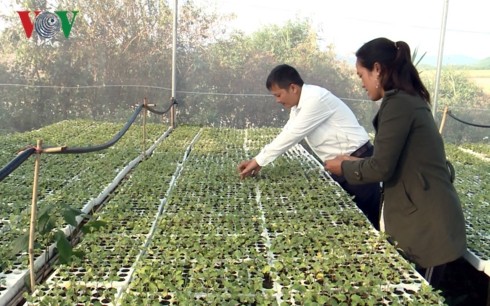(VOVWORLD) - Backward production methods create a bottleneck in the economic development of many ethnic minority villages in the Central Highlands. A Ba Na girl in a remote village in Gia Lai province has changed traditional farming by undertaking a project to grow medicinal herbs using advanced technology. Taking advantage of available resources, changing ways of thinking and doing, and applying technical advances are helping the locals develop their economy.

The high-tech medicinal tea project is praised for great potential for boosting economic growth in ethnic minority villages in Gia Lai province.
(Photo: Cong Bac)
|
Dinh Thi Vien, a Ba Na girl who lives in remote Po Nang village in Gia Lai province, and her high-tech medicinal tea project are surprising many local villagers. Viên said because growing traditional crops like sugar cane and cassava recently has had lots of trouble making a decent profit, the locals must look in new directions.
Through social networks, Vien discovered that the species solanum hainanense hance, which is widely used in her village, enjoys strong market demand.
Vien found a business to partner with and supported by the local government and fellow villagers, launched a project that has the potential to boost the entire village’s economy.
“As a Ba Na person, I want to see my fellow villagers start growing medicinal herbs. The species solanum hainanense hance is already available. We just need to know how to collect, grow and process it. The villagers themselves are consumers. This project will generate new jobs for the locals, especially women and youths,” Vien said.
The idea first came to Vien in 2017. One year later her medicinal herbal tea project was deployed in Po Nang village. 10 local households now participate in the pilot program, growing herbs on 2 hectares.
The herbs are grown organically using high-tech methods and an irrigation system that conserves water. In order to balance supply and demand, the farmers have worked closely with nearby cooperatives.
Le Van Bo, Director of the Tu An Agriculture Cooperative in Gia Lai province, credits the cooperative’s decision to work with the Po Nang villagers for the project’s strong potential.
Bo recalls: “When we met Vien, she and the villagers were already planning to put the species solanum hainanense hance into mass production. Their determination convinced us to cooperate with them. We plan to make and sell tea bags because the product has strong health benefits.”
The project is in the top 20 of 128 agricultural projects for which the Government Committee for Ethnic Minority Affairs has requested the World Bank’s financial support, and is part of a program to achieve rapid, sustainable economic growth in remote, isolated, ethnic minority areas.
Nguyen Thanh Canh, Chairman of the Tu An Commune People's Committee, says that once it is listed in the World Bank top 5, the project will be funded.
Even without World Bank funding, the project will continue in Po Nang and will eventually be expanded to other ethnic minority villages, Canh said, adding: “Based on the results of this pilot project, we will expand to three other ethnic minority villages. The Po Nang model and will be continued in Nhoi village and Hoa Binh village.”